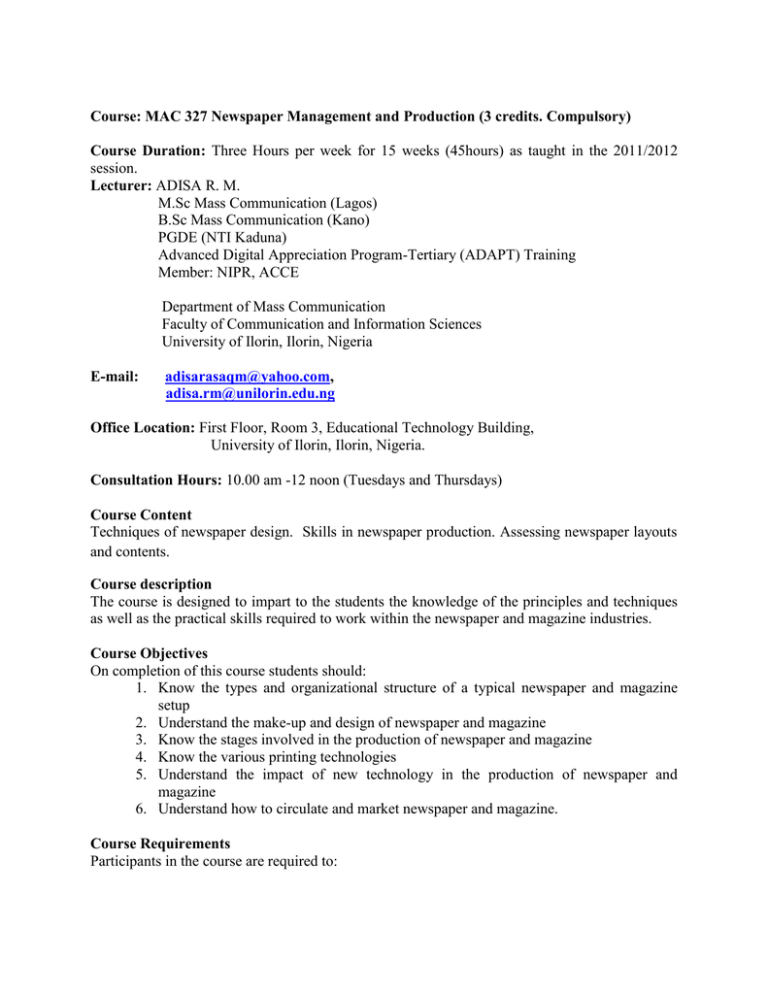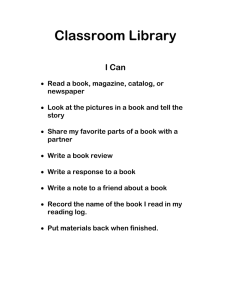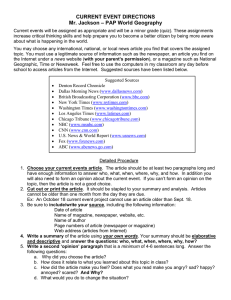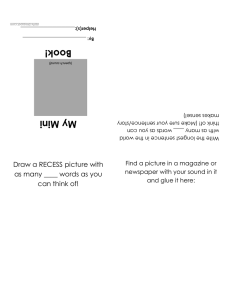Course: MAC 327 Newspaper Management and Production (3 credits. Compulsory) Lecturer:
advertisement

Course: MAC 327 Newspaper Management and Production (3 credits. Compulsory) Course Duration: Three Hours per week for 15 weeks (45hours) as taught in the 2011/2012 session. Lecturer: ADISA R. M. M.Sc Mass Communication (Lagos) B.Sc Mass Communication (Kano) PGDE (NTI Kaduna) Advanced Digital Appreciation Program-Tertiary (ADAPT) Training Member: NIPR, ACCE Department of Mass Communication Faculty of Communication and Information Sciences University of Ilorin, Ilorin, Nigeria E-mail: adisarasaqm@yahoo.com, adisa.rm@unilorin.edu.ng Office Location: First Floor, Room 3, Educational Technology Building, University of Ilorin, Ilorin, Nigeria. Consultation Hours: 10.00 am -12 noon (Tuesdays and Thursdays) Course Content Techniques of newspaper design. Skills in newspaper production. Assessing newspaper layouts and contents. Course description The course is designed to impart to the students the knowledge of the principles and techniques as well as the practical skills required to work within the newspaper and magazine industries. Course Objectives On completion of this course students should: 1. Know the types and organizational structure of a typical newspaper and magazine setup 2. Understand the make-up and design of newspaper and magazine 3. Know the stages involved in the production of newspaper and magazine 4. Know the various printing technologies 5. Understand the impact of new technology in the production of newspaper and magazine 6. Understand how to circulate and market newspaper and magazine. Course Requirements Participants in the course are required to: 1. A minimum of 75% attendance qualifies students for writing the end of semester examination in this course; 2. All written assignments and feature stories must be word processed; 3. Deadline must be strictly observed. Late assignments will attract penalties; 4. Each student is expected to have a yahoo e-mail account, join and participate in the course’s online discussion group. Methods of Grading Performance in the course will be graded using the guidelines in the table below. Criterion Percentage Score of Total Marks Test 10 Assignment/Project 15 Participation in online discussion group 5 Final Examination 70 Total 100 Course Delivery Strategies The main method of course delivery is face-to-face lectures, discussions, and small group exercises and practical some of which shall be presented in the class. Lecture Contents Week 1: Introduction to Print Media Objectives The objectives of this week lecture are to explain the meaning and characteristics of newspaper and magazine. To do this, various definitions, origin and development of print media will be discussed. Description First Hour Meaning of magazine and newspaper. Second Hour Origin and development of Newspaper Third hours History and scope Evolution of newspaper in Nigeria Opportunities and constraints of Nigeria print media. Study Questions 1. Trace the history of newspaper in Nigeria 2. Outline the development of newspaper in Nigeria 3. What are the factors that boosted magazine production in Nigeria? 4. List Nigerian newspapers in circulation 5. List all magazines publish and in circulation in Nigeria Reading List 1. Okoye4 I. (2004) Magazinology. Lagos: Mebyi&Associates,pp2-10.ISBN 978-35652-8-1. 2. Conboy4 M. (2005) “The Print Industry – Yesterday, Today and Tomorrow: An Overview” in: Keeble R. (Ed.) Print Journalism A critical introduction. USA: Routledge, pp 4-8. ISBN 0-203-00676-3 3. www.mediaawareness.ca/newspapers_magazines 3 Week 2: Types and Organizational Structure of Newspaper Objective Students will be acquainted with the knowledge of the types and organizational structure of a typical newspaper and magazine industries. Also, functions and responsibilities of the various principal officers in the print media will be pointed out. Description First Hour Identification and categorization of the major divisions in a newspaper and magazine organization Second Hour Analyses of the major divisions Third Hour Roles and functions of principal officers of newspaper and magazine Study Questions 1. List the organizational structure of a newspaper house. 2. Explain the organizational structure of a newspaper house. 3. Draw the organizational chart of standard newspaper. 4. Identify the roles and functions of publisher, sub-editor, production editor and managing editor. 5. Who is a production editor? Reading List 1. Okoye4 I. (2000). Newspaper Editing and Production in the Computer Age. Lagos: Mbeyi and Associate, pp 2. Cole4 P. (2005). “The structure of the print industry”, in: Keeble R. (2005) Print Journalism A critical introduction. USA: Routledge, pp. 30-38. ISBN 0-203-00676-3. 3. Niblock4 S. (2005). Inside Journalism. London: Blueprint, pp. 13-19. ISBN 0-20340173-5. Week 3: Classification of Magazine Objective The main objective of this week lecture is to classify magazine into various kinds and subject matter. Generally all magazines can be categorized into three main types: the in–house, professional and consumer magazines. Description First Hour Identification of the major divisions in a newspaper and magazine organization Meaning and features of in- house magazine Second Hour Meaning and features of professional or technical magazine Meaning and features of consumer magazine Third Hour Classification of consumer magazines according to subject matter General interest magazine Soft sell magazine Sports magazine News magazine Study Questions 1. What are the major classifications of magazine? 2. List 10 examples, each, of general interest, soft sell, sports and news magazines. 3. Describe the features of professional magazine. 4. Explain, with examples, the general interest magazine. 5. List 20 examples of news magazines in Nigeria. Reading List 1. Adisa4 R. M. (2005). Fundamentals of Newspaper/Magazine Editing and Production. Osogbo: positive Impact Publications, pp 25-32.ISBN 978-32581-4-3. 2. Niblock4 S. (2005). Inside Journalism. London: Blueprint, pp 56-61. ISBN 0-203-401735. Weeks 4-5: Design and Make-up of Newspaper and Magazine Objective Students will understand and able to explain the whole process of newspaper and magazine design and make-up. Description First Hour Meaning and features of in- house magazine Meaning of design and layout Second Hour (Week 4) Elements of a page i.e. text, headlines, photo and advert Special devices in page make up e.g. indenting, drop letters, boxes etc. Third Hour (Week 4) Pages and pagination of newspaper and magazine. First Hour (Week 5) Space budgeting in newspaper and magazine. Second Hour Design and layout practices in newspaper and magazine production e.g. balance rhythm, unity, contrast, harmony etc. Third Hour (Week 5) Kinds of make-up e.g. vertical, horizontal, symmetrical, asymmetrical make-up. Study Questions 1. Describe balance, unity, rhythm, and contrast in relation to design and layout of newspaper and magazine. 2. What are the major elements of newspaper page? 3. Explain the process of newspaper and magazine design and layout. 4. How is space budgeting in newspaper carried out? Reading List 1. Adisa4 R. M. (2005). Fundamentals of Newspaper/Magazine Editing and Production. Osogbo: positive Impact Publications, pp 103- 110. ISBN 978-32581-4-3. 2. Frost4 C. (2005). “Design for print media” in Richard K. (Ed.) Print Journalism A critical introduction. London: Routledge, pp 201- 204. ISBN 0-203-00676-3. 3. Tattersall4 M. (2008). “Page layout and design” in Franklin B. (Ed.) Pulling Newspapers Apart, Analysing Print Journalism, London: Routledge, pp 196-203. ISBN 0-203-63070X Week 6: Elements of print layout Objective The main objective of this week is to distinguish between different visual characters that form the element of newspaper and magazine layout. Description First Hour Essential elements such as typography, pictures, colour, white space, text boxes, headlines. Second Hour Application of the elements on a computer Third Hours Typefaces, different point sizes Study Questions 1. What is layout? 2. List and explain the essential elements of newspaper and magazine layout. 3. What is the significance of special effects on newspaper pages? 4. Select two newspapers and mark out boxes, highlight and shadow. 5. On your own, access a desk top publishing package on a computer and select the range of fonts available. Enter the words ‘Mass Communication Department’ on screen and experiment by using: I. _ different typefaces II. _ different point sizes III. _ upper and lower case IV. _ regular and bold V. _ serif and sans serif VI. _ italics VII. _ special effects such as shadow, underline, strike through and drop capitals. Reading List 1. Rudin 4R. and Ibbotson T. (2002). An Introduction to Journalism: Essential techniques and background knowledge. Oxford: Focal Press, pp 78-93. ISBN 0 240 51634 6. Weeks 7-8: Newspaper and Magazine Production Stages Objective The main objectives of this week are to enable students understand both the theory and practical stages involved in the production of a newspaper and magazine. Description First Hour (Week 7) Construction of grids. Second Hour Dummy page outline Third Hour (Week 7 in the Editing Lab) Opening a new file on the computer and set the required columns. Masthead and logo placing into the designated area. First Hour Body text from a file or disc placing in the relevant columns. Second Hour (Week 8 in the Editing Lab) Body text from a file or disc placing in the relevant columns. Printing of pages either on a laser or ink-jet printer for proofreading. Third Hour (Week 8) Correction of changes made on the document, saving and printing of final work. Study Questions 1. Describe dummy sheet. 2. Draw a rough sketch of newspaper pages on a dummy sheet to include positions of advertisements, graphics, pictures, headlines, and body text. 3. Draw up a ‘dummy’ of the front page of a campus newsletter using guidelines discussed this week. 4. Select a tabloid and a broadsheet newspaper published on the same day and compare and contrast the layout of the front pages in terms of headlines, stories, pictures, typography, use of white space, use of colour, etc. Write an analysis on the differences in layout and the possible impact on readers. 5. List and explain proofreading symbols. Reading List 1. Adisa4 R. M. (2005). Fundamentals of Newspaper/Magazine Editing and Production. Osogbo: positive Impact Publications, pp 25-32.ISBN 978-32581-4-3. 2. Rudin4 R. and Ibbotson T. (2002). An Introduction to Journalism. Oxford: Focal Press, pp 86-89 ISBN 0 240 51634 6. 3. Smith4 B. (2003). proofreading, revising, & editing skills success in 20 minutes a day. New York: LearningExpress, pp 189-190. ISBN 1-57685-466-3. Week 9: Design and Make-up of Different Pages of Newspaper Objective This week objectives are to explain the dynamics and grading of different pages of newspaper. Description First Hour Front page design techniques. Characteristics of page one Second Hour Back page design techniques. Characteristics of back page. Third Hour Inside pages techniques. Characteristics of the inside pages. Characteristics of the opinion-editorial pages. Study Questions 1. Describe newspaper page one format. 2. What are the items contained on the front and back pages folios? 3. What types of specialized reporting are mostly found in Nigerian newspapers? 4. Why is Op-ed regarded as important content of newspaper? 5. Explain the characteristics of back page of a National newspaper. Reading List 1. Adisa4 R. M. (2005) Fundamentals of Newspaper/Magazine Editing and Production. Osogbo: positive Impact Publications, pp 111-119.ISBN 978-32581-4-3. Weeks 10-11: Printing Technologies Objective This week objectives are to acquaint the students with the knowledge of the various techniques for newspaper and magazine printing. Description First Hour (week10) History of printing. Second Hour (week 10) Letter press printing Principles. Third hour (Week 10) Principles of Lithography First Hour (Week 11) Intaglio print making technique Second Hour Modern innovations- computer printing Digital printing Third Hours (Week 11) Screening Stochastic screening Study Questions 1. Trace the history of printing technologies. 2. Write short note on letter press and lithography printing methods. 3. What is Intaglio printing? 4. Describe digital and screen printing. 5. List and give brief analysis of five printing machines. Reading List 1. 1.Adisa4 R. M. (2005) Fundamentals of Newspaper/Magazine Editing and Production. Osogbo: positive Impact Publications, pp. 120- 133. ISBN 978-32581-4-3. 2. Okoye4 I. (2004) Magazinology. Lagos: Mebyi&Associates, pp. 96-98. ISBN 978-356528-1. Week 12: Computer to Film and Computer to Plate Printing Methods Objective This week lecture will acquaint students with the new imaging technology i.e. Computer to film and Computer to plate Production Process in newspaper and magazine industries. Description First Hour Desktop Publishing (DTP) Second Hour Computer to film (CTF), where the computer file is output onto a photographic film. Third Hour Computer to plate (CTP). Advantages and disadvantages of CTF and CTP. Study Questions 1. Describe the process of computer to film. 2. What are the special features of computer to plate? 3. Compare and contrast CTF and CTP. 4. List advantages and disadvantages of CTF and CTP. 5. What is Desktop printing? Reading List 1.Desktop publishing-Wikipedia, the free encyclopedia3, http://en.wikipedia.org/wiki/DTP. Accessed 14 November, 2009. available at Week 13: Starting Magazine and Newspaper Publication Objective The main objectives of this week are to explain to students all the initial steps required to start publishing a newspaper or magazine. Description First Hour Feasibility study or initial research. Second Hour Blueprint – detail plan. The publication formula. Third Hour Format-physical appearance of the publication. Design-prototype. Economics-funding. Study Questions 1. Describe the feasibility study required when starting a national newspaper in Nigeria. 2. How is blueprint for a new magazine prepared? 3. Select two standard Magazines published in Nigeria and analyze their formula. 4. List 15 magazines published in Nigeria. 5. Select one magazine each from Nigeria and America or Britain, then describe their formula. Reading List 1. Okoye4 I. (2004). Magazinology. Lagos: Mebyi&Associates, pp. 37-47. ISBN 97835652-8-1. Week 14: Newspaper and Magazine Circulation Objective The main objective is to explain the meaning and dynamics of circulation of newspaper after production. Also, students will be acquainted with the roles and relevance of Audit Bureau of Circulation. Description First Hour Meaning of circulation Classification of newspaper according to circulation. Second Hour Roles and relevance of Audit Bureau of Circulation. Third Hour Problems of newspaper and magazine circulation. Study Questions 1. Define newspaper circulation and distribution. 2. Classify Nigerian newspapers according to circulation 3. How relevant is ABC in Nigeria? 4. What are the problems confronting ABC? 5. Explain the problem limiting newspaper and magazine circulation in Nigeria. Reading List 1. Adisa4 R. M. (2005). Fundamentals of Newspaper/Magazine Editing and Production. Osogbo: positive Impact Publications, pp. 151- 163. ISBN 978-32581-4-3. 2. Franklin4 B., Hamer M., Hanna M., Kinsey M.and. Richardson J. E. (2005). Key Concepts in Journalism Studies. London: SAGE Publications, p. 36. ISBN 1 7619 4481 8. Week 15: Revision Objectives Being the last class on the course students would be expected to seek for clarification and explanation on any difficult topic or area treated during the course. Revision Questions 1. Outline the development of newspaper and magazine in Nigeria. 2. List Nigerian newspapers in circulation. 3. List all magazines publish and in circulation in Nigeria. 4. What are the major classifications of magazine? 5. List 10 examples, each, of general interest, soft sell, sports and news magazines. 6. What are the major elements of newspaper page? 7. Explain the process of newspaper and magazine design and layout. 8. List and explain the essential elements of newspaper and magazine layout. 9. What is the significance of special effects on newspaper pages? 10. Describe dummy sheet. 11. List and explain proofreading symbols. 12. What are the items contained on the front and back pages folios? 13. What types of specialized reporting are mostly found in Nigerian newspapers? 14. Why is Op-ed regarded as important content of newspaper? Reading List 1. Adisa4 R. M. (2005). Fundamentals of Newspaper/Magazine Editing and Production. Osogbo: positive Impact Publications, pp 25-32.ISBN 978-32581-4-3 2. 3. Cole4 P. (2005). “The structure of the print industry”, in: Keeble R. (2005) Print Journalism A critical introduction. USA: Routledge, pp 30-38. ISBN 0-203-00676-3. 4. Conboy4 M. (2005). “The Print Industry – Yesterday, Today and Tomorrow: An Overview” in: Keeble R. (Ed.) Print Journalism A critical introduction. USA: Routledge, pp 4-8. ISBN 0-203-00676-3 5. Franklin4 B., Hamer M., Hanna M., Kinsey M.and. Richardson J. E. (2005). Key Concepts in Journalism Studies. London: SAGE Publications, p. 36. ISBN 1 7619 4481 8. 6. Frost4 C. (2005). “Design for print media” in Richard K. (Ed.) Print Journalism A critical introduction. London: Routledge, pp 201- 204. ISBN 0-203-00676-3. 7. Okoye4 I. (2004). Magazinology. Lagos: Mebyi&Associates,pp2-10.ISBN 978-35652-81. 8. Okoye4 I. (2000). Newspaper Editing and Production in the Computer Age. Lagos: Mbeyi and Associate, pp 9. Tattersall4 M. (2008). “Page layout and design” in Franklin B. (Ed.) Pulling Newspapers Apart, Analysing Print Journalism, London: Routledge, pp 196-203. ISBN 0-203-63070X 10. Niblock4 S. (2005). Inside Journalism. London: Blueprint, pp 13-19 ISBN 0-203-401735. 11. www.mediaawareness.ca/newspapers_magazines 3 12. Desktop publishing-Wikipedia, the free encyclopedia3, http://en.wikipedia.org/wiki/DTP. Accessed 14 November, 2009. KEY 1- Available in the University Library 2- Available in local bookshops 3- Available on the Web. 4- Personal collection 5- Departmental libraries available at





